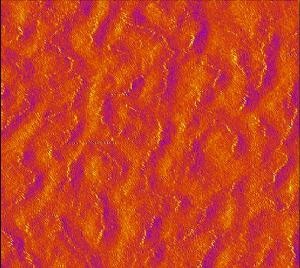Feb 1 2019
Ten years ago, researchers observed that dumping buckyballs—carbon molecules resembling soccer balls—onto a specific type of multilayer graphene resulted in a flat carbon nanomaterial, which is a relatively unusual phenomenon.
 A microscope view of tiny buckyballs lined up on a layered graphene surface. New research shows that that electrically charged crinkles in the graphene surface are responsible for the strange phenomenon. (Image credit: Kim Lab/Brown University)
A microscope view of tiny buckyballs lined up on a layered graphene surface. New research shows that that electrically charged crinkles in the graphene surface are responsible for the strange phenomenon. (Image credit: Kim Lab/Brown University)
Instead of rolling around arbitrarily just like how marbles do on a hardwood floor, the buckyballs assembled spontaneously into single-file chains that expanded across the surface of the graphene.
Now, at Brown University’s School of Engineering, scientists have demonstrated how this phenomenon actually works and that elucidation could lead to a novel type of controlled molecular self-assembly. The Brown research team has reported the results of the study in Proceedings of the Royal Society A, demonstrating that small and electrically charged crinkles present in graphene sheets are capable of interacting with the surface molecules, thus organizing those molecules in electric fields along the crinkles’ paths.
What we show is that crinkles can be used to create ‘molecular zippers’ that can hold molecules onto a graphene surface in linear arrays. This linear arrangement is something that people in physics and chemistry really want because it makes molecules much easier to manipulate and study.
Kyung-Suk Kim, Study Senior Author and Director, Center for Advanced Materials Research, Institute for Molecular and Nanoscale Innovation, Brown University.
The latest study is a follow-up to previous studies carried out by Kim’s group. In that initial study, the researchers demonstrated that when sheets of layered graphene are gently squeezed from the side, they deform in an unusual manner. Instead of forming gently sloping wrinkles as one might notice in a rug that has been crumpled against a wall, the compressed graphene sheets form sharp saw-tooth crinkles over the surface. Kim’s study revealed that these crinkles are formed because the electrons’ arrangement within the graphene lattice makes the wrinkle’s curvature to localize along a sharp line. In addition, the crinkles are electrically polarized, with crinkle valleys and peaks carrying a strong positive charge and a strong negative charge, respectively.
Kim and his research team believed that the electrical charges along the crinkles may elucidate the buckyballs’ unusual behavior, partially because a different kind of multilayer graphene was applied to the original buckyball experiments—for example, HOPG is a graphene that naturally forms crinkles when produced. However, the researchers had to positively demonstrate that the charge produced by the crinkles can interact with the external molecules present on the surface of the graphene, and this is what they had done in this latest study.
The researchers’ analysis utilizing density functional theory—a quantum mechanical model of the way the electrons are organized in a material—estimated that positively charged crinkle valleys should be able to produce an electrical polarization in the buckyballs that are otherwise electrically neutral. That electrical polarization should make the buckyballs to line up, each in the same direction in relation to one another and spaced around 2 nm apart.
Those hypothetical predictions closely correlate with the outcomes of the original buckyball experiments and also with the repeat experiments recently reported by Kim and his research group. The close correlation between experiment and theory demonstrates that graphene crinkles can certainly be used for directing molecular self-assembly, with buckyballs as well as with other types of molecules.
According to Kim, this molecular zippering capability could lead to many promising uses, especially in exploring biomolecules like RNA and DNA. For instance, if DNA molecules are extended out linearly, it can possibly be sequenced in a faster and easier manner. At present, Kim and his team are testing the viability of this approach.
There’s a lot of potential here to take advantage of crinkling and the interesting electrical properties they produce.
Kyung-Suk Kim, Study Senior Author and Director, Center for Advanced Materials Research, Institute for Molecular and Nanoscale Innovation, Brown University.
Mrityunjay Kothari, Moon-Hyun Cha, and Victor Lefevre were Kim’s co-authors on the paper. The National Science Foundation (CMMI-1462785 and 1563591) supported the study.